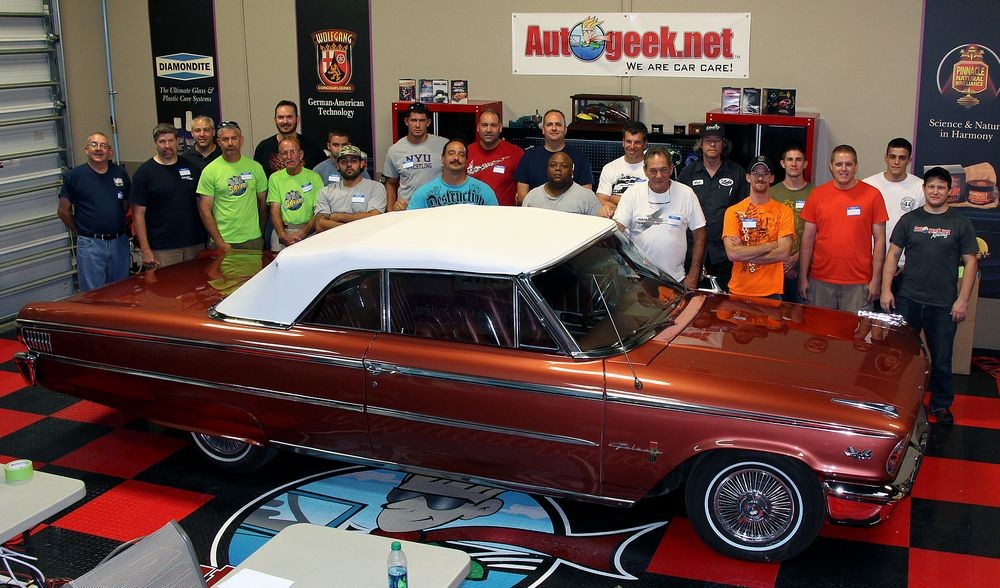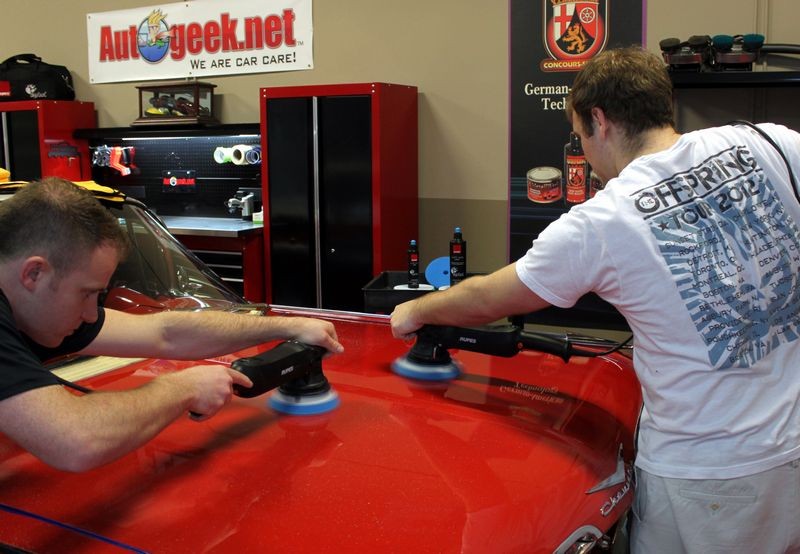Nick McKees37
McKee's 37 Product Support
- Jan 6, 2011
- 7,265
- 0
"Does that thing really have the power to remove paint defects?"...arguably the most frequently asked question about the Rupes LHR 75E Mini Random Orbital Polisher. My answer has always been an enthusiast YES!
"Mini" (ie: 3 inch) polishers aren't exactly known for being powerhouses, but Rupes is changing that trend with the recently introduced LHR 75E Mini Random Orbital Polisher. In America we call that "having your cake and eating it."
Rupes LHR 75E Mini Random Orbital Polisher

Rupes LHR 75E = An easier way to polish small and intricate body panels
My answer to the obvious question about the Rupes LHR 75E and its immense correction ability is usually followed with prove it. Prove it I shall!
Fortunately enough, Andre's Kona Blue Mustang had a handful of Type II water spots on the hood, making it the perfect test subject for proving how capable the Rupes LHR 75E Mini Random Orbital Polisher is at removing defects.
3 - Types of Water Spots - Type I, Type II and Type III
Type II water spots on the hood of a Kona Blue Ford Mustang

Rupes Microfiber Pads

I've been itching to demonstrate Rupes' new microfiber pads (color coordinated just like their foam pads), so I went ahead and slapped one on my LHR 75E Mini Random Orbital Polisher, grabbed a bottle of Rupes Zephir Gloss Compound, and went to work!

Up Close & Personal: Rupes LHR 75E Mini Random Orbital Polisher
Rupes, a pioneer in the polishing industry, listened to the requests of professional detailers and car care enthusiasts and created a 3 inch mini polisher that is powerful enough to remove swirls and scratches with ease. The Rupes LHR 75E features a massive 12 mm orbit, giving it the correction ability that professional detailers demand. The powerful 400 watt motor ensures the LHR 75E doesn’t bog down under light loads. The Rupes LHR 75E includes a 3 inch backing plate that is designed for 3, 3.5, and 4 inch pads.

Ergonomically Perfect
With its non-slip rubber inserts on the front cover, the LHR 75E is perfect for all polishing operations in difficult to reach areas. The operator can work in perfect comfort to produce the best possible results.

On-Off Switch Lock
Lined in non-slip rubber, the on/off switch of the Rupes LHR 75E ensures a controlled soft start, giving the operator full control over the tool.
Design
The attention to detail is not limited to just the innovative and attractive design. The modern lines and exceptional technical quality are combined with a number of details that are the result of meticulous research aimed at achieving maximum operator comfort. The non-slip rubber inserts are numerous and have many functions. In particular, the insert on the machine body is used to support the polisher when placed on a surface.

Color Coordinated Pads & Chemicals
Just like their foam pads, Rupes Microfiber Pads are color matched to their compounds and polishes.
Rupes Zephir Gloss Coarse Gel Compound is the 1st step in the Rupes Big Foot Polishing System. This ultra-heavy cut compound utilizes advanced abrasive technology that quickly eliminates up to 1500 grit sanding marks on fresh paint while leaving little to no haze.

Here's Andre handling the Rupes LHR 75E Mini Random Orbital Polisher. Speed 4, medium downward pressure, and a slow arm speed.

Lookin' good!

To further refine the surface and increase clarity, Andre polished the area again using a Rupes Microfiber Finishing Pad and Rupes Keramik Gloss Polish.

Speed 3, light downward pressure, and a medium arm speed.

Easy wipe off
One thing I've always like about Rupes compounds and polishes is the fact that they're easy to remove.

Goodbye water spots, hello glossy paint!
The Rupes LHR 75E Mini Random Orbital Polisher equipped with Rupes Microfiber Pads and Rupes Compounds removed the type II water spots with little effort. Even at speed 4 and moderate downward pressure, the machine still maintained pad rotation.

If you've been looking for a mini polisher that packs a punch, your search is over thanks to the Rupes LHR 75E Mini Random Orbital Polisher.
Rupes LHR 75E Mini Random Orbital Polisher
Rupes Big Foot Random Orbital Polishing System
"Mini" (ie: 3 inch) polishers aren't exactly known for being powerhouses, but Rupes is changing that trend with the recently introduced LHR 75E Mini Random Orbital Polisher. In America we call that "having your cake and eating it."
Rupes LHR 75E Mini Random Orbital Polisher

Rupes LHR 75E = An easier way to polish small and intricate body panels
The Rupes LHR 75E Mini Random Orbital Polisher is a professional detailer’s dream come true. You will finally be able to remove swirls and scratches from small and intricate body panels with speed and precision. The Rupes LHR 75E Mini Random Orbital Polisher is the first and only mini dual action car polisher that was developed with the professional detailer in mind. The Rupes LHR 75 Mini Random Orbital Polisher and its compact design, powerful 400 watt motor, and massive 12 mm throw will make this versatile car polisher a vital component of every detail.
My answer to the obvious question about the Rupes LHR 75E and its immense correction ability is usually followed with prove it. Prove it I shall!
Fortunately enough, Andre's Kona Blue Mustang had a handful of Type II water spots on the hood, making it the perfect test subject for proving how capable the Rupes LHR 75E Mini Random Orbital Polisher is at removing defects.
3 - Types of Water Spots - Type I, Type II and Type III
Mike Phillips said:Type II Water Spots are actual etchings or craters in the paint because something corrosive in a water source has landed on the paint and was not removed before a portion of the paint was eaten or dissolved by the corrosive substance.
Type II water spots on the hood of a Kona Blue Ford Mustang
Rupes Microfiber Pads

Rupes is known for setting trends in the automotive refinishing industry, and their revolutionary new microfiber cutting and polishing pads continue this tradition. Designed and manufactured entirely in house, Rupes Microfiber Pads promise to offer superb cutting and finishing abilities along with outstanding durability.
Rupes Microfiber Pads feature several new industry-firsts, including a polyurethane resin that is injected directly into the structure between the Velcro interface and the microfiber fabric. The resin adheres directly to both materials to provide a stable and secure bond without using adhesives. This enables Rupes Microfiber Pads to outlast and outperform other microfiber pads on the market.
Thanks to the unique molding technique, Rupes is able to offer a pad that can conform to convex shapes during the polishing process, similar to a traditional foam pad. This ensures that Rupes microfiber pads are making contact with the surface 100% of the time, reducing polishing time and improving the overall finish quality.
Rupes Microfiber Pads are the first of their kind to offer spiral slots in the design of the pad. The innovative spiral slots represent an important technical improvement with a unique design. These spiral slots dissipate heat at an enormous rate, allowing the pad and the paint to stay cooler.
Rupes Microfiber Pads are available in two configurations and multiple sizes:
Rupes Blue Microfiber Cutting Pad
Rupes Blue Microfiber Cutting Pad is designed for removing heavy swirl marks, oxidation, scratches, water spots, and sanding marks from all paint systems. The Rupes Blue Microfiber Cutting Pad features a short and dense microfiber pile and is perfect for use with heavy cutting Rupes Big Foot Polishing Compound, like Zephir Gloss or Quarz Gloss. The special microfiber material allows for the true correction power of the product used.
Rupes Yellow Microfiber Finishing Pad
Rupes Yellow Microfiber Finishing Pad is designed to restore the depth and clarity to your vehicle’s paintwork. The long and soft microfiber pile is perfect for removing light swirl marks, holograms, and water spots using an ultra fine Big Foot Polishing Compound, like Keramik Gloss or Diamond. Rupes Yellow Microfiber Finishing Pads eliminate light imperfections while delivering a perfect finish.
I've been itching to demonstrate Rupes' new microfiber pads (color coordinated just like their foam pads), so I went ahead and slapped one on my LHR 75E Mini Random Orbital Polisher, grabbed a bottle of Rupes Zephir Gloss Compound, and went to work!
Up Close & Personal: Rupes LHR 75E Mini Random Orbital Polisher
Rupes, a pioneer in the polishing industry, listened to the requests of professional detailers and car care enthusiasts and created a 3 inch mini polisher that is powerful enough to remove swirls and scratches with ease. The Rupes LHR 75E features a massive 12 mm orbit, giving it the correction ability that professional detailers demand. The powerful 400 watt motor ensures the LHR 75E doesn’t bog down under light loads. The Rupes LHR 75E includes a 3 inch backing plate that is designed for 3, 3.5, and 4 inch pads.
Ergonomically Perfect
With its non-slip rubber inserts on the front cover, the LHR 75E is perfect for all polishing operations in difficult to reach areas. The operator can work in perfect comfort to produce the best possible results.
On-Off Switch Lock
Lined in non-slip rubber, the on/off switch of the Rupes LHR 75E ensures a controlled soft start, giving the operator full control over the tool.
Design
The attention to detail is not limited to just the innovative and attractive design. The modern lines and exceptional technical quality are combined with a number of details that are the result of meticulous research aimed at achieving maximum operator comfort. The non-slip rubber inserts are numerous and have many functions. In particular, the insert on the machine body is used to support the polisher when placed on a surface.
Color Coordinated Pads & Chemicals
Just like their foam pads, Rupes Microfiber Pads are color matched to their compounds and polishes.
Rupes Zephir Gloss Coarse Gel Compound is the 1st step in the Rupes Big Foot Polishing System. This ultra-heavy cut compound utilizes advanced abrasive technology that quickly eliminates up to 1500 grit sanding marks on fresh paint while leaving little to no haze.
Here's Andre handling the Rupes LHR 75E Mini Random Orbital Polisher. Speed 4, medium downward pressure, and a slow arm speed.
Lookin' good!
To further refine the surface and increase clarity, Andre polished the area again using a Rupes Microfiber Finishing Pad and Rupes Keramik Gloss Polish.
Speed 3, light downward pressure, and a medium arm speed.
Easy wipe off
One thing I've always like about Rupes compounds and polishes is the fact that they're easy to remove.
Goodbye water spots, hello glossy paint!
The Rupes LHR 75E Mini Random Orbital Polisher equipped with Rupes Microfiber Pads and Rupes Compounds removed the type II water spots with little effort. Even at speed 4 and moderate downward pressure, the machine still maintained pad rotation.
If you've been looking for a mini polisher that packs a punch, your search is over thanks to the Rupes LHR 75E Mini Random Orbital Polisher.
Rupes LHR 75E Mini Random Orbital Polisher
Rupes Big Foot Random Orbital Polishing System








